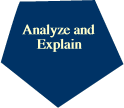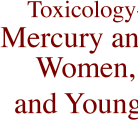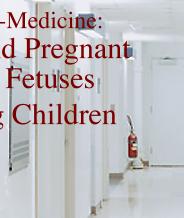 |
|||
 |
||||
CALENDAR |
||||||||||||||
HOME |
||||||||||||||
Mercury
Clean Air Act (CAA) industrial mercury emissions control: creation of mercury hot spots? Can Hg emission credits be traded like those for gaseous emissions (carbon dioxide)?
Recent research of relationship between autism risk and industrial mercury hot spots raises questions about affect of trading emission credits on creations of Hg hot spots .
The joint EPA-FDA Advisory on mercury and fish consumption: what it says and does not; what it means and does not. Clearing up the confusion [see . Guidelines, fact sheets and frequently asked questions [see Toxicology & the Home].
New research on low level neurotoxic effects of mercury: scientific evidence on both sides of the controversy [see Toxicology of Science].
EPA responds to petitions from States, Environmental Groups and Indian tribes to reconsider changes to the CAA that would allow cap trading of mercury releases. Review events leading up to recent development. Public comments invited (deadline for comments was December 17, 2005).

Exposure Assessment
Most advisories or commentaries refer to ‘high mercury’ fish and ‘low mercury’ fish, but this doesn’t accurately reflect the groupings of fish or the choices, and so tends to blur the issue rather than clarify it. Any division is necessarily somewhat arbitrary, but there is a good argument to divide fish into five groupings, from ‘highest’ to ‘high’ to 'mid-range' to ‘lower' and 'lowest'. There is approximately a doubling (or more) of mercury concentration moving up the grouping (low to moderate; moderate to high; high to highest) and an eight-fold increase from low to highest. These categories are identified with the concerns of mercury poisoning in young children, and pregnant women and fetuses, in mind. Only the lowest category of fish meets the FDA-EPA Advisory of allowable consumption per week. the concentration in Chunk Light Tuna exceeds those guidlelines. These guidelines are meant to convey advice on how best to choose what to eat and what not to eat at certain times. In that regard, it is more appropriate to label a category as ‘high’ if it has four times the concentration of mercury of the lower category, and label as 'mid range' the category that has approximately four times the concentration of mercury as that in the lowest category.
By looking at these different categories and determining the Omega-3-Fatty Acids in each grouping, one can make a more informed decision as to what risks and what attendant benefits one wants to take, under various circumstances and at different points in time (See: Table 1: Fish Mercury / Omega 3's )
4. Exposure and dose assessment
Since it is not possible to determine the concentration and location of mercury in the brains of fetuses or young children a surrogate of exposure and of dose is required. And surrogates leave room for error and misinterpretation. Maternal blood, maternal hair, or neonatal hair or blood, or placental or cord blood mercury can serve as indicators of exposure or dose, but each has limitations. Hair tends to provide a more accurate indication of (average) chronic exposure but cannot pinpoint peak exposures, which may be critical in the developing brain. Blood sampling can provide real time exposures but without multiple sampling may miss peak exposures or incorrectly reflect chronic exposure. The exact timing of peak exposures vis a vis critical developmental periods is difficult to determine even with multiple sampling. Questions have also been raised about the consistency of measurements of one parameter to another, such as cord blood to maternal blood, or maternal hair to maternal blood, i.e., that the ratio between the two is known and stable. Variation from one study to another has been shown, however, as stated, to show an overall picture of consistency among a wide range of good data.
Three epidemiological studies were considered to establish a reference dose: the Seychelles (Myers et al, 1995; 1997; Davidson et al, 1995, 1998), the Faroes (Grandjean et al, 1997 ) and the New Zealand Study ( Kjellstrom et al, 1986, 1989). Although all three were judged to be of high quality, the Faroes was considered the one to base the RfD, as it measured both maternal hair and cord blood, was backed up by the findings of the New Zealand study and was consistent with the wide body of data about neurotoxic effects. Although the Seychelles study was considered a high quality study as well, it’s negative findings were thought inconsistent not only with the two other epidemiological studies but with the wide body of data showing neurotoxic effects in the offspring of mothers exposed to mercury.
Both the Faroes and New Zealand studies showed not simply an effect of mercury, compared to no or low mercury exposure, but a dose response, which is a stronger indicator of an effect. That is, as the exposure and dose rose, so did the measurements of neurological and neuropsychological functioning show a greater decline.
As reported in IRIS, the abnormal neurological testing was related to blood levels ranging from 46 ppb to 76 ppb mercury, reflecting an intake of 0.857 to 1.45 ug/kg bw/day. Testing in children populations tends to show a normal ‘bell curve’ of effect, with the majority of children placing somewhere in the middle and then smaller percentages showing higher or lower scores at each end of the curve, respectively. By looking at the lowest five percent in the distribution with abnormal scores on the Boston Naming Test (considered in these as a reliable indicator of neurobehavioral functioning), a blood level of 58 ug/L was calculated. (This was after the lowest five percent of the distribution was left out of the calculations as low intellectual functioning of this distribution is due to factors other than mercury poisoning.) The 58 ug/L corresponded to a daily mercury intake of 1.0 ug/kg bw/day (or 7.0 ug/kg bw / week).



